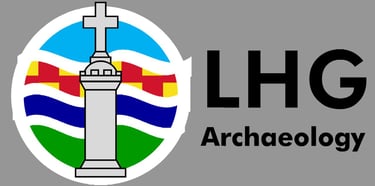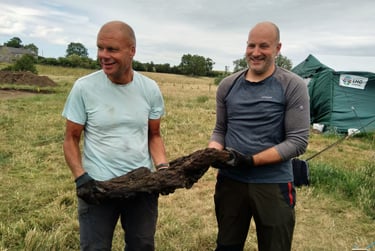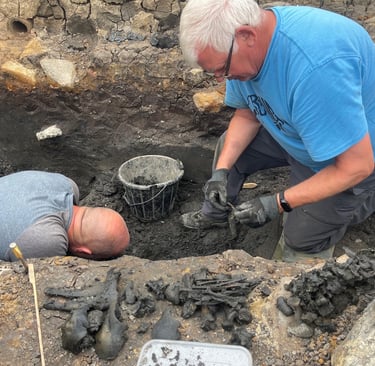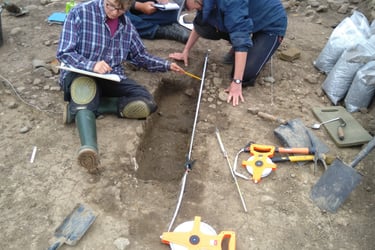Hunting Hall Archaeology Blog
A daily account of our Hunting Hall dig.


28th June 2025 : Dig Diary Day 27
Thanks to Kristian for his account of the day
On our penultimate day in the field for this season's investigations, we have fortunately elucidated some of the structures and patterns that had previously confused us. In Trench 10, we have multiple phases of occupation: the cobble filled ditches have been recut on at least three occasions. In the most recent fill, we have recovered Iron Age ceramic, albeit we are unable to assign this to any period of the Iron Age as it is quite coarse and has no diagnostic characteristics to suggest a closer temporal assignment. This pattern is also seen in the palisade ditch, where there are intrusions by postholes or pits. A lower surface has emerged where Karen and Ailsa were excavating, suggesting that there might be yet another and an older horizon beneath all the occupation debris that we have encountered this season. Additionally, there are subtle vestiges of a roundhouse platform that was disturbed by the construction of the palisade ditch and the enigmatic 'ring ditch' which seems, on the balance of evidence, to perhaps be another roundhouse platform lacking any domestic features within its circuit. We were able to establish the multiple recuts of the ditches by the work undertaken by Ethan and Lorna this afternoon.
The excavations in Trench 8, which cuts across the inner ditch enclosing the site on the western approaches, has provided a vast amount of faunal evidence. We have also recovered a considerably well preserved log, which may have fallen into the ditch when it was abandoned, but equally may have been a post of some sort that toppled. It is of likely a hardwood, and of sufficient diameter, that dendrochronological dating is a possibility for us. This will provide us with a single calendar year in which the log was felled. A concentration of small mammal bone in a part of the ditch where Julian was excavating is perplexing, for the skeletons seem to be largely intact. None of these seem to afford much nutritional value, but they may be juveniles that perished and were deposited within the trench. A more considered interpretation of this must await faunal analysis and determination of the species present. We believe that we may see the cutting for the trench, which is scarcely as deep as we have progressed. This suggests that the ditch was dug into an older, natural deposit replete with necrotic clay. The accumulation of so much organic material militates against any argument for a rivulet, for the current would presumably wash this away, so the likelihood is that we have fortuitously encountered the vestiges of a kettle hole. A core was kindly taken, with immense effort, by Julian, Mark, and Dominic, assisted by John Home Robertson. This ought to provide us with an excellent environmental history of the site.
Tomorrow shall largely be focused on the drawing of sections in both trenches, and the collection of more samples, so do join us to see the results from the fieldwork before we proceed to the post-excavation analysis in GarageLab.






